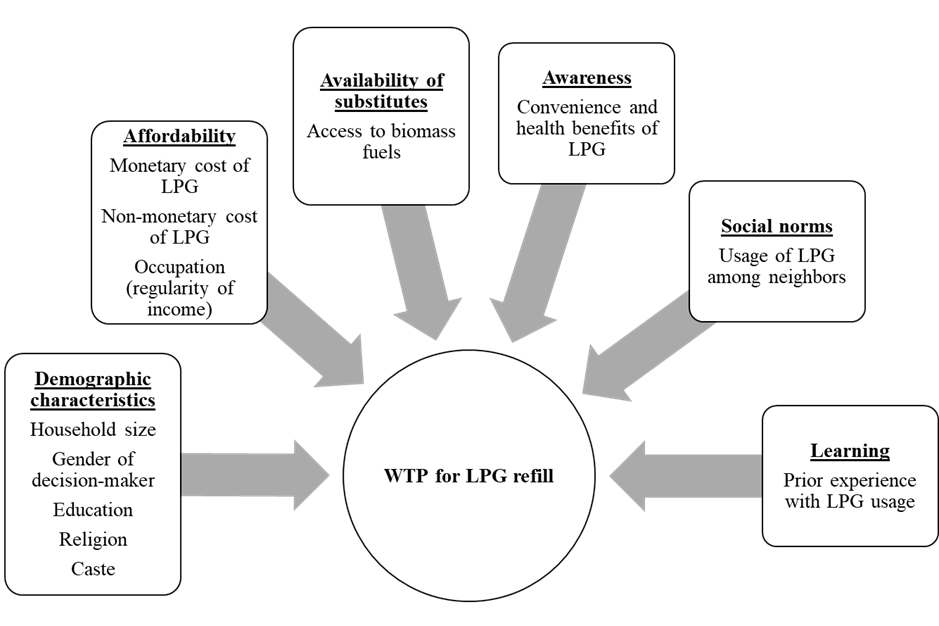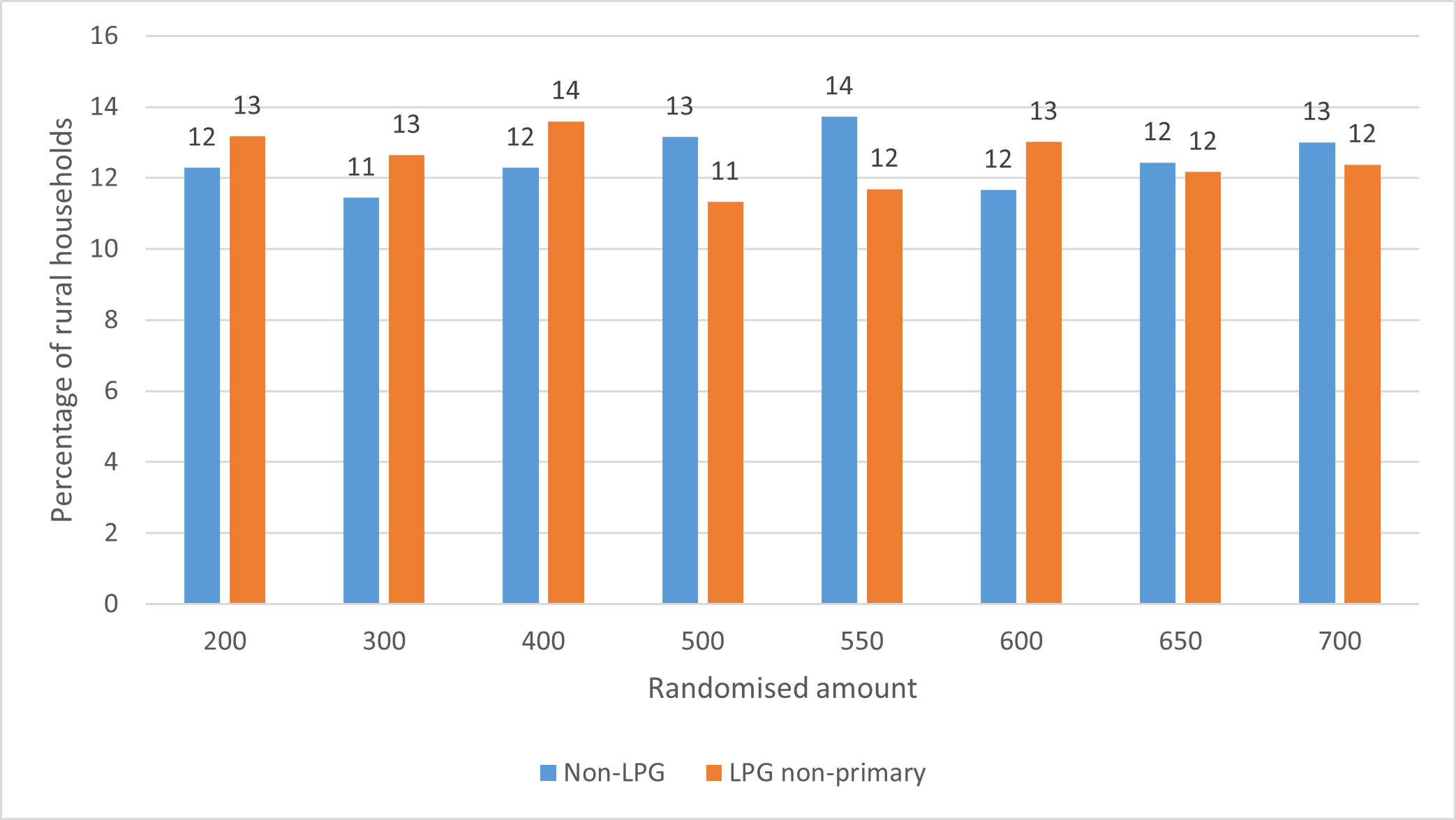Background
Indoor air pollution caused by the use of traditional biomass as cooking fuel leads to approximately 500,000 deaths every year in India (India State-Level Disease Burden Initiative Air Pollution Collaborators, 2019). Policy interventions, therefore, have tried to increase the access to and affordability of liquefied petroleum gas (LPG), a clean cooking fuel. For instance, the Government of India's flagship scheme - Pradhan Mantri Ujjwala Yojana (PMUY), aims at expanding LPG coverage in the country, particularly among the economically poor and marginalised. The Government of India estimates that, as of March 2020, 97.4 per cent of Indian households used LPG as either their primary or complementary cooking fuel; a significant part of which is being attributed to PMUY (Ministry of Petroleum & Natural Gas, 2020). Yet, rural households continue to rely on traditional cooking fuels in some form or another (International Energy Agency, 2019; Jain et al., 2018; Mani et al., 2020). Why does exclusive LPG usage continue to be low despite significant subsidies for LPG refills, and what can be done to promote exclusive and sustained use of LPG? Our research - see Chindarkar, Jain & Mani, 2021 for the details - tries to answer this question.
Our study uses surveys of rural households in six energy-access-deprived states in India - 4021 households that did not use LPG at all for cooking (non-LPG households) and 1,866 that used LPG but not as their primary cooking fuel (LPG non-primary households). In the first part of the research, we examined the factors that affected households' willingness-to-pay (WTP) for exclusive LPG use. And in the second, using a contingent valuation approach, we determined the average WTP for exclusive use of LPG.
Determinants of WTP for exclusive use of LPG
Our analytical framework - the demographic, economic, behavioural, and policy-related determinants of WTP for the exclusive use of LPG for cooking - is presented in Figure 1.
Figure 1. Factors determining WTP for exclusive use of LPG

Source: Chindarkar et al. (2021)
We used 'single-bounded dichotomous choice contingent valuation' (CV) questions. This means that a respondent had to answer just 'Yes' or 'No', when asked if they were willing to pay a specified amount (bid) for the use of LPG exclusively for cooking. We generated a number of bid values and assigned them randomly to the respondents. Figure 2 shows the different bid values, and the percentage of non-LPG households and the percentage of LPG non-primary households covered by each bid value.
Figure 2. Distribution of households by randomly assigned bid values

Source: Chindarkar et al. (2021)
We estimated regression models correlating the dichotomous 'Yes' or 'No' answer to the bid values with variables operationalizing the determinants from our analytical framework. Our findings suggested that, first, among demographic characteristics, only household size was positively and statistically significantly associated with WTP for exclusive use of LPG. Other demographic characteristics such as involvement of women in household decision-making, education of the household head, and caste and religion of respondent were uncorrelated with WTP. Second, as expected, economically better-off households were more likely to pay for exclusive use of LPG. Third, households with irregular cash flows were less likely to pay for exclusive use of LPG compared to households with regular cash flows. Fourth, households that had access to free biomass such as dung cakes had a lower WTP for exclusive use of LPG. In contrast, higher monthly expenditure on purchased biomass was positively associated with WTP. Finally, and most importantly, awareness about LPG's health benefits and community-level diffusion of LPG were positively and significantly correlated with WTP for exclusive use of LPG.
Estimate of WTP for exclusive use of LPG
Using estimates from the regression models, we computed the mean monthly WTP for exclusive use of LPG for non-LPG and LPG non-primary households. Our computations suggested that the mean monthly WTP for non-LPG households was INR 453 and for LPG non-primary households it was INR 471. To put things into perspective, the subsidized cost of a 14.2 kilogram LPG refill is INR 580 (as of April 2020). On average, a rural household requires 8-9 LPG refills annually. This translates to a monthly equivalent expenditure of INR 386 - 435. Essentially, we found that mean monthly WTP was higher than the effective monthly cost of subsidized LPG.
Admittedly, these mean values hide heterogeneity across the sample. On average, the likelihood that a household would be willing to pay INR 386 - 435 per month for exclusive use of LPG was only about 55 - 62 per cent. Among households that responded with a 'No' to the presented bid value, 90 per cent cited unaffordability as the main reason. We estimated that among rural households that did not use LPG as their primary cooking fuel, 40 - 45 per cent would be unwilling to use it exclusively at the current subsidized price. These findings thus call for further policy scrutiny of low exclusive use of LPG for cooking.
Policy implications
First, given the heterogeneity in WTP for exclusive use of LPG for cooking, the current approach of providing a flat subsidy to all households seems less effective. Instead, better targeting based on criteria such as affordability thresholds, household economic index, and occupation or seasonality of income, is recommended.
Second, there could be other barriers pertaining to affordability such as lumped cost of LPG refills vis-a-vis small and short-term payments. Currently, the subsidy is deposited in the bank account only after LPG refill is purchased; moreover, for many rural households a bank account itself is not easily accessible. Therefore, other payment methods such as small pre-payments towards LPG refills or encouraging micro-savings for refills through self-help groups, need to be designed.
Third, the dependence of rural households on biomass for cooking could be reduced by encouraging value-chains for traditional biomass such that an opportunity cost is created for these fuels thereby decreasing their availability.
Fourth, awareness about the benefits of LPG for cooking has to be created and communicated to the right audience. Our data suggests that while women are primary cooks for the household, in 90 per cent of the households, the main decision-maker is the male head. Therefore, an awareness and communication strategy that involves both men and women is needed.
Fifth, in our data, we find that WTP for exclusive use of LPG for cooking increases sharply after 18-24 months of adoption. Policymakers need to leverage this learning effect. They could give households that are newly connected to LPG at least two years to accustom themselves to using LPG and then conduct follow-up studies to identify and target households whose LPG usage remains low.
And last, as social norms around traditional cooking methods and community-level usage of LPG are significant determinants of exclusive use of LPG for cooking, targeted community-level efforts in areas with low penetration are needed. Engaging community influencers to assuage the fear associated with LPG use, and providing information about schemes and application procedures, should be prioritized.
In brief, a multi-pronged policy approach is required to promote and sustain exclusive use of LPG for cooking.
References
- Chindarkar, N., Jain, A., & Mani, S. (2021). Examining the Willingness-to-Pay for Exclusive Use of LPG for Cooking Among Rural Households in India. Energy Policy, 150(112107).
-
India State-Level Disease Burden Initiative Air Pollution Collaborators. (2019). The Impact of Air Pollution on Deaths, Disease Burden, and Life Expectancy Across the States of India: the Global Burden of Disease Study 2017. Lancet Planetary Health, 3, e26-39.
- International Energy Agency. (2019). SDG7: Data and Projections. Retrieved from https://www.iea.org/reports/sdg7-data-and-projections/access-to-clean-cooking
- Jain, A., Tripathi, S., Mani, S., Patnaik, S., Shahidi, T., & Ganesan, K. (2018). Access to Clean Cooking Energy and Electricity Survey of States 2018. Retrieved from New Delhi:
- Mani, S., Jain, A., Tripathi, S., & Gould, C. F. (2020). The Drivers of Sustained Use of Liquified Petroleum Gas in India. Nature Energy, 5, 450-457.
- Ministry of Petroleum & Natural Gas. (2020). LPG Profile: Data on Marketing and Distribution. New Delhi: Ministry of Petroleum & Natural Gas.

Source: Chindarkar et al. (2021)

Source: Chindarkar et al. (2021)
About The Author

Prof. Namrata Chindarkar
JSW School of Public Policy
Ph.D. in Policy Studies (International Development Concentration), School of Public Policy, University of Maryland – College Park, USA